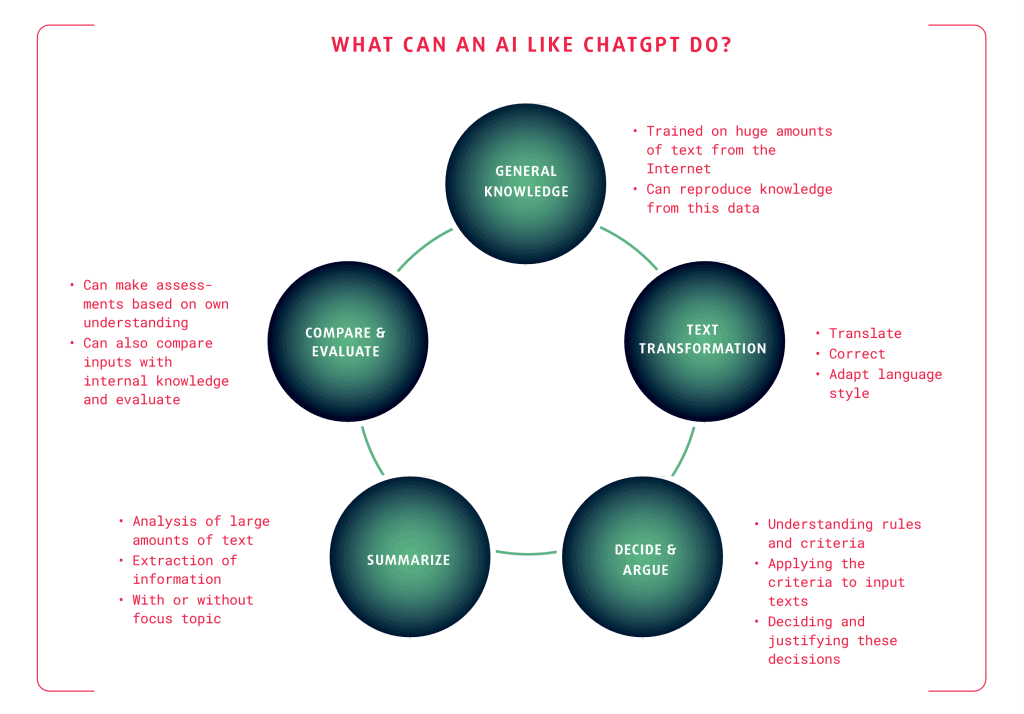Artificial Intelligence
How ChatGPT & Co. are changing the way we work
“We will try to bring AI to the streets in Germany,” Hubertus Heil recently assured us. The Federal Minister of Labor is convinced that by 2035, no company will be able to manage without artificial intelligence (AI). However, many German companies are currently still critical of this. So what can AI actually achieve – and in which fields of work?
While many countries are already investing heavily in AI applications, their use is still met with skepticism in Germany. The industry association Bitkom surveyed 603 German companies with more than 20 employees on the topic. The result: only one in six companies plans to create texts with the help of AI applications such as the chatbot ChatGPT, while 29% rule out the use of AI completely.
Will AI create jobs or eliminate them?
In Germany, the main fear is that AI will lead to job losses. “Of course, AI applications influence human activities and professions, just as machines have always done,” says Jörg Kiesewalter, Senior Manager at Lurse. “But the key to using AI is not simply to rationalize through automation, but to enable companies to provide services that they were previously unable to do. So it’s not about replacing, but about enhancing and supporting human work – and not losing touch.”
AI can change the world of work more than any previous technology. It requires new qualifications, and by replacing human activities, it in turn creates completely new occupational fields. The limits of AI still lie in human intention and social interaction. However, it can already be used effectively in some areas, as the following graphic shows.

Suitable areas of application
According to a brief study by the Fraunhofer Institute for Industrial Engineering, AI will influence many job profiles over the next five years, including management and engineering professions. But what jobs are we talking about specifically? And what are the prerequisites for the use of AI? Broadly speaking, activities can be divided into routine activities, interaction work and knowledge and innovation work.
AI-capable routine activities are, for example, simply structured, repetitive measurements, checks and quality controls, paperwork, calculations and bookings. An AI can, for example, process forms or monitor technical processes – provided that standardized and structured data is available.
Interaction work, on the other hand, includes tasks in training, personnel management and consulting. For example, AI can be used to automatically analyze applications or answer customer inquiries. This requires sufficient and high-quality data, training and AI adaptations.
Finally, knowledge and innovation work involves intellectual outputs that are difficult or impossible to plan. Information is incomplete, problems and solutions are unclear. Possible applications of AI include research, planning, research, programming and data processing. If AI has access to suitable sources of information, it can significantly simplify and accelerate the collection and structuring of information.
Effects on the world of work
“Initially, AI will mainly take over routine tasks, especially those where problems and solutions are known and standardized, structured data is available,” summarizes Jörg Kiesewalter. However, where the use of AI is not worthwhile for economic reasons, the proportion of routine work will increase and can be carried out by people who are trained.
“However, as it develops further, AI will soon be able to use less structured and volatile data.” Automation affects professions at every level of complexity and qualification. Knowledge-based and interactive activities such as analysis, creative cross-disciplinary collaboration, employee management and negotiation will become increasingly important.
As the flexibility requirements of their customers continue to increase, companies should therefore focus more on specialist and knowledge-based work and give their employees extensive freedom of action and decision-making. Automation using AI mainly makes sense for long-term, standardized, less complex processes. Human intelligence, on the other hand, makes this automation possible in the first place by eliminating faults and orchestrating the technology. Semi-skilled labor is still irreplaceable where full automation is uneconomical or manual dexterity is required.
Tasks of human resources management
When it comes to making companies fit for the future in terms of AI, HR has a key role to play. Six areas of responsibility are affected:
- HR strategy: this includes planning, current and future job architecture and skills management.
- Internal HR processes and systems: This should include a detailed analysis of the internal use of AI in the context of self-services, recruitment and analytics.
- Corporate culture and leadership: HR managers should support employees when it comes to AI and, above all, keep an eye on their need for security.
- Internal communication: The aim here is to create clarity and address and dispel fears and prejudices about AI.
- Training and qualification: This includes promoting an understanding of the technology and enabling experiments and pilot projects with AI.
- Creating framework conditions: This relates to issues such as co-determination, compliance, governance, etc.
Above all, it is important to examine which new tasks and roles will be created by AI and which requirements and skills will change. Reliable gap analyses are also required, for example on critical future skills, resources and qualifications.
AI in HR – also a question of ethics
“The use of AI in a sensitive area such as HR management also raises ethical questions,” explains Jörg Kiesewalter. “The guidelines of the HR-Tech Ethics Advisory Board help with orientation.” There are five points to consider:
- Objectives and involvement: The objectives for the use of AI in HR work must be transparent, comprehensible and participatory. It is important to involve the various interest groups such as employee representatives, data protection officers and ethics officers.
- Quality and safety: These should be ensured for AI systems through measures such as validation, testing, monitoring or certification. AI systems should be robust, reliable and fault-tolerant.
- Transparency and traceability: The functionality, data sources, objectives and possible effects of AI systems should be documented, explainable and auditable. Users and those affected by AI systems must be informed about them.
- Fairness and non-discrimination: Measures for diversity, inclusion or bias minimization should ensure that employees are neither disadvantaged nor favored by AI systems.
- Responsibility and accountability: Those responsible for the use of AI systems should implement governance, compliance or grievance mechanisms to ensure compliance with legal and ethical requirements and assume liability in the event of possible damage.
“Last but not least, the use of AI requires a systematic and strategic approach within the company,” says Jörg Kiesewalter. “Every company must clarify where and how AI influences work activities, skills and functions, and therefore their value, and how the organization’s adaptability can be ensured. Lurse is happy to support its partners in this process.”
This article and more can be found in the current issue of our customer magazine “Spotlight”, which is available to download free of charge!

